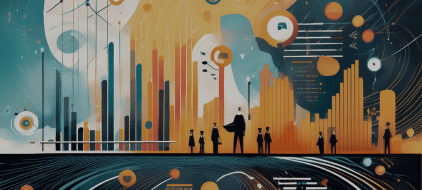It was a crisp Monday morning in January when Priya walked into her new office for the first time. Fresh out of university, she was both excited and anxious. As she stepped into the sleek, modern building, she noticed a quote etched onto the glass wall near the reception desk: “Diversity is being invited to the party; inclusion is being asked to dance.”
Priya didn’t think much of it then. She was too busy navigating her onboarding paperwork and meeting her new team. But as the weeks turned into months, the meaning of that quote slowly came to life in her workplace. It wasn’t just a feel-good phrase printed on a wall—it was a philosophy embedded in the company’s DNA. Her journey at this organization would teach her—and all of us—valuable lessons about the importance of diversity and inclusion (D&I) in today’s workplaces.
A Tale of Two Workplaces
Before joining her current role, Priya had interned at another company, a place where diversity was more of a checkbox than a commitment. The office was homogeneous, with little variation in age, gender, or cultural background. Discussions were often dominated by a select few, and ideas that challenged the status quo were rarely encouraged.
In contrast, her new workplace felt alive. Teams were vibrant with a mix of voices, each bringing their unique experiences to the table. She worked alongside individuals from different ethnicities, genders, generations, and even abilities. Conversations were rich, debates were constructive, and innovation thrived. It was here that Priya truly understood the power of a diverse and inclusive workplace—not just for the organization but for the people who were part of it.
What Does Diversity and Inclusion Really Mean?
Diversity and inclusion are often spoken of together, but they’re not the same thing. Diversity is about representation—ensuring a mix of individuals from different backgrounds, cultures, and perspectives are present in the workplace. Inclusion, on the other hand, is about creating an environment where those individuals feel valued, heard, and empowered to contribute their best work.
For Priya, the distinction became clear during a brainstorming session. As the youngest member of the team, she hesitated to voice her ideas, fearing they might be dismissed. But her manager noticed her silence and encouraged her to speak up. When she shared her thoughts, they sparked a lively discussion that ultimately shaped the direction of the project. That moment wasn’t just about diversity; it was about inclusion—making sure every voice at the table mattered.
The Business Case for Diversity and Inclusion
As Priya grew in her role, she began to notice how her company’s D&I initiatives weren’t just about doing the right thing—they were also smart business strategies.
- Innovation Through Diversity: Teams with diverse perspectives came up with solutions that were more creative and effective. Priya’s own team launched a product feature that addressed accessibility needs, a move that opened up a new market segment.
- Attracting Top Talent: Job seekers, especially Millennials and Gen Z, prioritize employers who value diversity. Priya’s company had no shortage of applicants because it was known for its inclusive culture.
- Improved Employee Engagement: When employees feel included, they’re more likely to be engaged and loyal. Priya noticed this firsthand in the low turnover rates and high morale within her department.
Studies back this up. According to a report by McKinsey & Company, companies with diverse leadership teams are 25% more likely to have above-average profitability.
How Companies Can Walk the Talk
Creating a truly equitable workplace takes more than a few training sessions or posters on the wall. Here’s how Priya’s company brought their D&I initiatives to life:
- Setting Clear Goals: The leadership team set measurable diversity goals, such as increasing the percentage of women in leadership roles by 20% within three years.
- Bias Training: Employees participated in workshops to identify and address unconscious biases, ensuring fair treatment in hiring, promotions, and daily interactions.
- Employee Resource Groups (ERGs): These groups provided a safe space for employees to connect, share experiences, and advocate for change. Priya joined the Young Professionals Network, which gave her mentorship opportunities and a sense of belonging.
- Inclusive Policies: From offering flexible work arrangements to accommodating religious practices, policies were designed to meet diverse needs.
- Leadership Commitment: Priya often saw senior leaders attending D&I events and championing the cause, sending a strong message about its importance.
The Challenges Along the Way
Of course, it wasn’t all smooth sailing. Priya’s company faced its share of challenges, from resistance to change to the occasional misstep in implementation. For example, an initial diversity campaign inadvertently excluded non-visible minorities, leading to some backlash.
But the organization treated these challenges as learning opportunities. They conducted open forums, listened to feedback, and adjusted their strategies. This transparency and willingness to improve further strengthened the trust between employees and leadership.
The Ripple Effect of Inclusion
One of Priya’s most memorable moments came during a company town hall. A senior leader shared his story of overcoming poverty and how the organization’s inclusive policies had helped him rise through the ranks. His words resonated deeply with Priya and many others, reinforcing the idea that inclusion isn’t just about bringing diverse people into the fold—it’s about giving them the tools and opportunities to succeed.
Looking Ahead: The Future of D&I
As Priya reflects on her journey, she’s optimistic about the future of diversity and inclusion in the workplace. The next frontier, she believes, lies in embracing intersectionality—the idea that people’s identities are multifaceted and interconnected.
Technology will also play a key role. AI-driven tools can help identify biases in hiring processes, while data analytics can track the effectiveness of D&I initiatives. But at its core, the success of these efforts will always depend on human commitment and empathy.
Final Thoughts
Priya’s story is a testament to the transformative power of diversity and inclusion. It’s about more than numbers or policies—it’s about building workplaces where everyone feels they belong, where their voices matter, and where their unique perspectives drive innovation and growth.
So, the next time you see a quote about diversity and inclusion etched on a wall, remember: it’s not just a slogan. It’s an invitation to create, collaborate, and thrive together. And that’s a vision worth dancing to.








